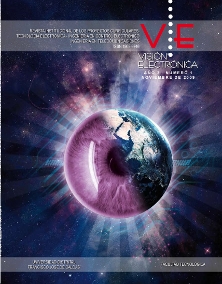DOI:
https://doi.org/10.14483/22484728.18449Published:
2019-12-06Issue:
Vol. 2 No. 2 (2019): Special editionSection:
A Research VisionSobre el concepto gauge, global y local, y su implementación en física
On the gauge concept, global and local, and its implementation in physics
Keywords:
Principio gauge, Transformación gauge, Invariancia gauge, Lagrangiano (es).Keywords:
Gauge principle, Gauge transformation, Gauge invariance, Lagrangiano (en).Downloads
Abstract (es)
Se realiza un análisis sobre el concepto gauge, global y local, ilustrando los aspectos más importantes sobre la manera de proceder para el establecimiento de la simetría gauge en electrodinámica clásica, mecánica cuántica y electrodinámica cuántica, mostrando cómo la simetría gauge produce un resultado que es físicamente significativo. Bajo este contexto, se implementa el concepto gauge haciendo uso del formalismo lagrangiano y exigiendo su invariancia bajo un grupo de simetría. Además, se bordan las ideas de Yang y Mills apoyadas en el grupo no abeliano SU (2) como una primera explicación sobre la dinámica de la interacción entre el protón y neutrón a partir de la conservación del isoespín. Este análisis revela como el concepto gauge se convierte en un paradigma para la construcción de explicaciones alrededor de los fenómenos a nivel atómico; explicación que se considera de difícil comprensión por parte de los estudiantes, lo que permite generar una forma alternativa, didáctica y robusta de abordar el tema para favorecer la adquisición de un conocimiento sobre los principios subyacentes en los que se fundamenta la física contemporánea.
Abstract (en)
An analysis is made on the gauge concept, global and local, illustrating the most important aspects on the way to proceed for the establishment of the gauge symmetry in classical electrodynamics, quantum mechanics and quantum electrodynamics, showing how the gauge symmetry produces a result that is physically significant. Under this context, the gauge concept is implemented using the Lagrangian formalism and demanding its invariance under a symmetry group. In addition, the ideas of Yang and Mills supported by the non-Abelian group SU (2) are embroidered as a first explanation about the dynamics of the interaction between the proton and the neutron from the conservation of the isospin. This analysis reveals how the gauge concept becomes a paradigm for the construction of explanations around phenomena at the atomic level; explanation that is considered difficult to understand by students, which allows generating an alternative, didactic and robust approach to the subject to favor the acquisition of knowledge about the underlying principles on which contemporary physics is fundamented.
References
W. Greiner, et al. “Gauge Theory of Weak Interactions”, Springer, New York, pp. 107-129, 2000. https://doi.org/10.1007/978-3-662-04211-3_4
W. Greiner, et al. “Quantum Mechanics Symetries”, Springer, New York, pp. 183-190, 1994.
H. Weyl, “Gravitation and Electricity”, Ann. Phys. vol. 59, p 101, 1918.
C. N. Yang and R. L. Mills, “Conservation of Isotopic Spin and Isotopic Gauge Invariance”. Rev. 96, p. 191, 1954. https://doi.org/10.1103/PhysRev.96.191
H. Weyl, “Space Time Matter”, New York, Dover Publications INC, pp. 282-295, 1952.
C. Quigg, “Gauge Theories of de Strong, Weak, and Electromagnetic Interactions”, Addison-Wesley, Canada, pp. 37-39, 1993.
M. Rozo, “Sobre la dinámica de una partícula en rotación usando el concepto de invariancia gauge”, Rev. Acad. Colomb. Cienc. Ex. Fis. Nat. vol. 40, no. 157, pp. 585-589, 2016. https://doi.org/10.18257/raccefyn.394
D. Griffiths, “Introduction to Electrodynamics”, Prentice Hall, USA, pp. 321-326, 1999.
L. Landau, et al. “Teoría clásica de los Campos”, Editorial Reverté S.A, pp. 61-70, 1992.
R. Feynman, “The Feynman lectures on Physics”, Vol III. Addison- Wesley Publishing Company, Masachusetts, E.U.A, pp. 15-17, 1964.
Y. Aharonov and D. Bohm, “Significance of Electromagnetic Potentials in the Quantum Theory. Phys. Rev. vol. 115, pp. 485-491, 1959. https://doi.org/10.1103/PhysRev.115.485
G. Rousseaux, R. Kofman, and O. Minazzoli, “The Maxwell lodge effect: significance of electromagnetic potentials in the classical theory”, Eur. J. Phys. vol. 49, pp. 249-256, 2008. https://doi.org/10.1140/epjd/e2008-00142-y
M. Semon, and T. John, “Thoughts on the magnetic vector potential”, Am. J. Phys. vol 64, no. 11, 1996. https://doi.org/10.1119/1.18400
D. Lencinella, and G. Matteucci, “An introduction to the vector potential”. Eur. J. Phys. vol. 25, pp. 249-256, 2004. https://doi.org/10.1088/0143-0807/25/2/011
E. J. Konopinski, “What the electromagnetic vector potential describes”, Am. J. Phys. vol. 46, no. 5, pp. 499-502, 1978. https://doi.org/10.1119/1.11298
E. S. Abers, B. W. Lee, “Gauge Theories”, Phys Reports. vol. 9, no. 1. pp. 1-141, 1973. https://doi.org/10.1016/0370-1573(73)90027-6
G. Kane, “Modern Elementary Particle Physics”, Addison-Wesley, USA, pp. 35-40, 1987.
S. F. Novaes, “Standard Model: An Introduction”, ed. 27, pp. 19-22, 2000.
D. Griffiths, “Introduction to Elementary Particles”, Wiley-VCH, Germany, pp. 159-162, 2008.
T. Cheng et al. “Gauge theory of elementary particle physics”, Oxford, New York, pp. 78-90, 1996.
M. Guidry, “Gauge Field Theories An Introduction with Applications, John Wiley & Sons, Inc, pp. 201-206, 1999.
W. Heisenberg, “Über den Bau der Atomkerne. On the Structure of Atomic Nuclei”. I. Z. Phys. p. 77, 1932. https://doi.org/10.1007/BF01342433
A. Sokolov, et al. “Electrodinámica Cuántica”, Editorial Mir, URSS, 103-107, 1989.
How to Cite
APA
ACM
ACS
ABNT
Chicago
Harvard
IEEE
MLA
Turabian
Vancouver
Download Citation
License
Copyright (c) 2019 Visión electrónica

This work is licensed under a Creative Commons Attribution-NonCommercial 4.0 International License.
1.png)
Attribution-NonCommercial 4.0 International






.jpg)





